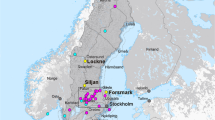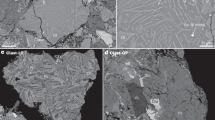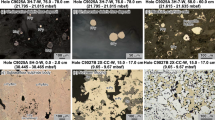Abstract
FOR over 1,000 years, the emerald deposits of Colombia have been the principal source of the world's largest and finest gem-quality emeralds—a variety of beryl containing chromium and vanadium1. Whereas most emerald deposits are found in association with igneous host rocks1, the Colombian deposits occur in organic-rich black shales, and their origin in the absence of any evidence of igneous activity has been a persistent enigma. Here we present evidence from the Muzo mine (located about 100km from Bogotá) that hydrothermal brines transported evaporitic sulphate to structurally favourable sites, where it was thermochemically reduced. We suggest that the sulphur generated by this process reacted with organic matter in the shales to release trapped chromium, vanadium and beryllium, which in turn enabled emerald formation.
This is a preview of subscription content, access via your institution
Access options
Subscribe to this journal
Receive 51 print issues and online access
$199.00 per year
only $3.90 per issue
Buy this article
- Purchase on Springer Link
- Instant access to full article PDF
Prices may be subject to local taxes which are calculated during checkout
Similar content being viewed by others
References
Sinkankas, J. Emerald and Other Beryls (Chilton Book, Radnor, Pennsylvania, 1981).
Beus, A. A. J. geochem. Explor. 11, 195–208 (1979).
Giuliani, G., Rodriguez, C. T. & Rueda, F. Miner. Deposita 25, 105–111 (1990).
Ottaway, T. L. thesis, Univ. Toronto (1991).
Pogue, J. E. Trans. Am. Inst. Min. and metall. Eng. 55, 810–34 (1916).
Giuliani, G., Cheilletz, A., Dubessy, J. & Rodriguez, C. T. in Proc. 8th Quadrennial Int. Ass. of the Genesis of Ore Deposits (IAGOD) Symp. (ed. Maurice, Y. T.) 159–168 (Schweizer-bart'sche, Stuttgart, 1993).
Kozlowski, A., Metz, P. & Jaramillo, H. A. E. Neues Jb. Miner. 159, 23–49 (1988).
Ottaway, T. L., Wicks, F. J., Bryndzia, L. T. & Spooner, E. T. C. Int. Mineralogical Ass. (Abstr. with Progms) 193 (Mineralogical Soc. of America, Washington DC, 1986).
Giuliani, G., Sheppard, S. M. F., Cheilletz, A. & Rodriguez, C. C. r. hebd. Seanc. Acad. Sci., Paris Série II, 314, 269–274 (1992).
Giuliani, G., Cheilletz, A., Baker, J. & Arhan, T. Archiwum Mineralogiczne XLIX, 83–84 (1993).
Orr, W. L. Bull Am. Ass. Petrol. Geol. 50, 2295–2318 (1974).
Orr, W. L. in Advances in Organic Geochemistry (eds Campos, R. & Goni, J.) 571–597 (Enadimsa, Madrid, 1977).
Meyers, P. A., Pratt, L. M. & Nagy, B. Chem. Geol. 99, 7–11 (1992).
Breit, G. N. & Wanty, R. B. Chem. Geol. 91, 83–97 (1991).
Püttmann, W., Fermont, W. J. J. & Speczik, S. Ore Geol. Rev. 6, 563–579 (1991).
Parnell, J. Chem. Geol. 99, 115–124 (1992).
Renders, P. J. thesis, Univ. Toronto (1985).
Ottaway, T. L. & Wicks, F. J. in Int. Gemological Symp. Proc. (ed. Keller, A. S.) 193 (Gemo-logical Inst. America, Santa Monica, 1991).
Nassau, K. The Physics and Chemistry of Colour: the Fifteen Causes of Colour (Wiley, Toronto, 1983).
Author information
Authors and Affiliations
Rights and permissions
About this article
Cite this article
Ottaway, T., Wicks, F., Bryndzia, L. et al. Formation of the Muzo hydrothermal emerald deposit in Colombia. Nature 369, 552–554 (1994). https://doi.org/10.1038/369552a0
Received:
Accepted:
Issue Date:
DOI: https://doi.org/10.1038/369552a0
This article is cited by
-
The parisite–(Ce) enigma: challenges in the identification of fluorcarbonate minerals
Mineralogy and Petrology (2021)
-
The role of evaporites in the formation of gems during metamorphism of carbonate platforms: a review
Mineralium Deposita (2018)
-
Formation and evolution of the Høgtuva beryllium deposit, Norway
Contributions to Mineralogy and Petrology (2015)
-
Sources and thermo-chemical sulfate reduction for reduced sulfur in the hydrothermal fluids, southeastern SYG Pb-Zn Metallogenic Province, SW China
Journal of Earth Science (2013)
-
The genesis of Colombian emeralds: a restatement
Mineralium Deposita (1996)
Comments
By submitting a comment you agree to abide by our Terms and Community Guidelines. If you find something abusive or that does not comply with our terms or guidelines please flag it as inappropriate.



